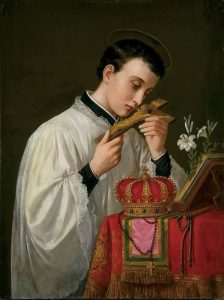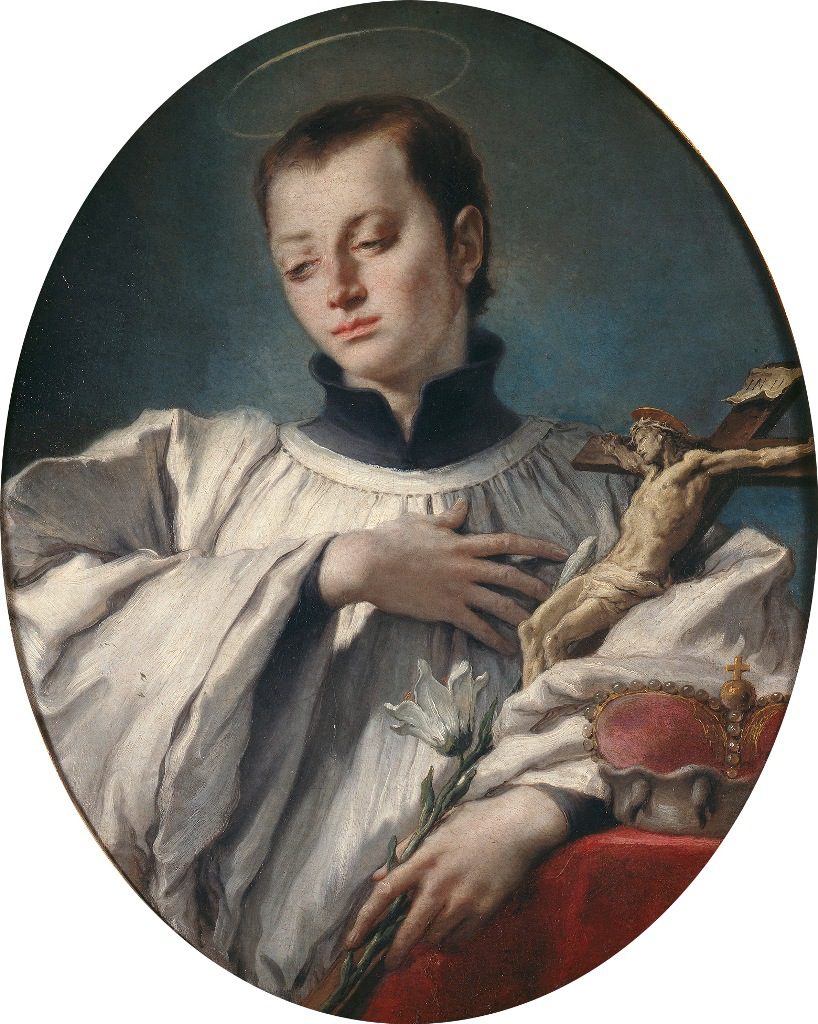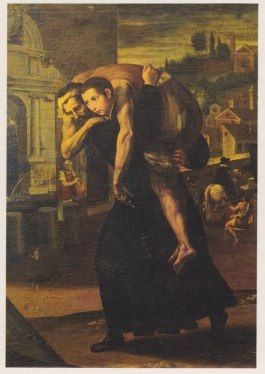 Run click, don’t walk click, to Crisis today to read Thomas J. Craughwell’s outstanding piece about St. Aloysius Gonzaga, a Jesuit saint (yes, there are some and they were amazing – shall we ever see their like again?) of high nobility who died at 23 years of age of plague in 1591.
Run click, don’t walk click, to Crisis today to read Thomas J. Craughwell’s outstanding piece about St. Aloysius Gonzaga, a Jesuit saint (yes, there are some and they were amazing – shall we ever see their like again?) of high nobility who died at 23 years of age of plague in 1591.
The writer recounts his surprise at learning how this patron of students and young people, so often depicted with saccharine pastel mushiness, was a jaw-set, hard-nosed rigorist who learned to soften – but not to lose his good rigidity – with the help of his spiritual director St. Robert Bellarmine (whom many people today would say was as rigid as they come).
A sample or two:
[…]
The Gonzagas were one of the great families of Renaissance Italy—rich, proud, influential, and often caught up in bloody feuds with one or another of the other famous Renaissance clans. During Aloysius’ lifetime his uncle and two of his brothers would be murdered in these vendettas, and his own mother, Marta, was wounded almost to death by a knife-wielding assassin. True to the Gonzaga type, Aloysius grew up headstrong, inflexible, and combative. But unlike his father, Ferrante, who looked to foreign wars as an outlet for his aggression, Aloysius resolved to conquer himself. He promised Our Lady to do all he could to keep himself free from vice, and as tends to happen among intense adolescents, he took his resolution to an extreme.
Culling bits and pieces from stories he had heard about ascetic saints, Aloysius cobbled together for himself a harsh program of religious exercises. He beat himself with a leather dog leash. He rose at midnight to pray on the bare, cold stone floor of his room. Poor St. Robert would contend with this relentless streak years later when Aloysius entered the Jesuit novitiate.
By 1583 Aloysius was convinced he had a religious vocation; he asked his mother to break the news to Ferrante. When Marta told her husband that his heir wanted to become a Jesuit, the old soldier exploded in rage.
[…]
In January 1591 an epidemic struck Rome and the surrounding countryside. Overnight the city’s hospitals were flooded with the sick and the dying. In the crisis Aloysius found that where once the sick had disgusted him, now he felt only compassion. He went into the streets of Rome and carried the ill and the dying to the hospital on his back. He undressed them, washed them, put fresh clothes on them, found them a bed or at least a pallet, and fed them. One Jesuit novice, a young man named Tiberio Bondi, testified later that after working with Aloysius he felt ashamed for holding back from the sick when his friend was giving his all. The years of low-key direction from St. Robert Bellarmine, the desire at last to cooperate with God’s grace, had wrought a great change in Aloysius: he no longer acted out of stubborn pride, now his actions were motivated by love.
[…]
Hard-Identity Catholicism.
May I just add that the Mass which formed him was the so-called Tridentine Mass, what we now often call the Extraordinary Form, the Usus Antiquior?
St. Aloysius Gonzaga, pray for us.


 […]
[…]































How do you pronounce Aloysius? I’ve always said Aloe-Ishus, where the I rhymes with the I in Dishes.
Yes, you’re right .The hmm manliest one is the guy hoisting a sick man . Had the casting director , or other directors,of the Harry Potter series ever seen the last one and aimed at the same, plus glasses? (Or perhaps both come from portrayals of St john at the cruxifiction , I have been told an artistic convention highlighting his not fully maturity ?)
acricketchirps, I was wondering that, too! I always pronounced it as you do (“Al-oh-ISH’-uhs”), but more than a few people pronounce it “A-LOY’-shee-uhs”. Does anyone know if either of these (or neither) is the “canonical” pronunciation?
paladin, acricketchirps, Al-o-WISH-uss is one of the two correct pronunciations, A-LOY-shee-uhs doesn’t seem to be. The wikipedia entry for this appears to be correct.
Hmm. Come to think of it, I also hear that dubya when I say it. I wonder where that comes from.
Thx.
Aloysius was my grandfather’s middle name, and it was pronounced Al-o-WISH-uss by the family. My great grandparents were from Freiburg, Germany.
But Father, but Father!
This post is terribly incomplete without the Metropolitan Museum’s great Guercino painting The Vocation of Saint Aloysius (Luigi) Gonzaga
[GMTA. I had originally included that painting, but saw that, because of its dimensions, the details were hard to see.]
I love reading unvarnished, non-sugarcoated renditions of saints’ lives.
I had never been fond of the Jesuits whom I saw as purveyors of Liberation Theology, but then I met Fr. John Hardon in person and heard him speak on several occasions and was at a Mass he offered at my parish in Chicago. I believe one day he will be recognized by the Church as the Saint he already is in Heaven.
Pingback: THURSDAY EXTRA | Big Pulpit
From across the pond, the figure of the English Jesuit Fr. Paul Crane (1910-1997), the founder of the journal “Christian Order”, also comes to mind. Although an octogenarian, he too remained “rigid and compassionate” in his defense of the Faith and his nonconformity to the progressive vision of the Second Vatican Oecumenical Council. Some of his recorded lectures are available from “Keep the Faith.”